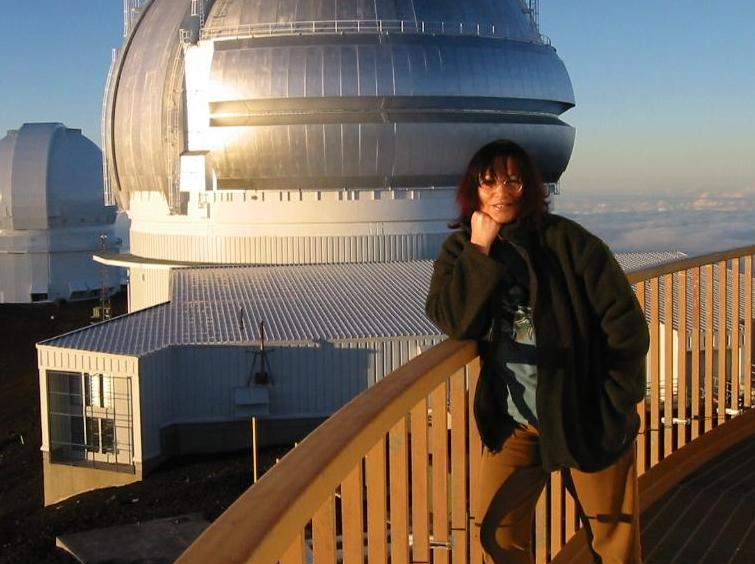
Isabella M. Gioia
AstrophysicistItalian Laurea in Physics, University of Bologna, Italy, 1970

|
Isabella M. GioiaAstrophysicistItalian Laurea in Physics, University of Bologna, Italy, 1970
|
|
I work in extragalactic observational astronomy with particular interest
in clusters of galaxies which, as the largest gravitationally bound
structures known, provide clear constraints on the formation of structure
and on the composition of the universe. My research is not confined to one
wavelength but builds on observations in several domains from radio to
optical and X-rays. I have been involved for many years in the construction
and identification of complete samples of radio and X-ray sources to study
the evolutionary properties of the different classes of astronomical
objects (from AGN to clusters of galaxies) using their luminosity functions,
source counts, etc. In the past I also investigated the role of distant
clusters as gravitational lenses .
The best known result from my work is the discovery of the "negative"
evolution of X-ray selected galaxy clusters
(Gioia et al. 1990a)
in the Einstein Extended Medium Sensitivity Survey
(EMSS: Gioia et al.
1990b), recently confirmed by the ROSAT North Ecliptic Pole (NEP) survey data
(Gioia et al. 2001) and by other independent complete samples of
galaxy clusters
I continue to work on follow-up studies of EMSS clusters. Observations with XMM-Newton of the z = 0.83 cluster MS1054-0321 allowed us to correct previous determinations of the X-ray temperature for this object (Gioia et al. 2004).
As part of the PhD thesis of Marica Branchesi we studied the
Radio Luminosity
Function (RLF) of 18 NEP distant galaxy clusters with redshift
betweeen z=0.3 and z=0.8 and found a change in the NEP RLF, both in slope and
amplitude with respect to the local cluster samples, and also the absence of
a break at log P_(1.4GHz) = 24.8 observed in nearby rich Abell clusters
(Branchesi et al. 2006) .
More recent work involves the analysis of Chandra archival observations
to quantify the role of X-ray point sources
in the inner regions of galaxy clusters
Branchesi et al. 2007 , and how they affect X-ray observable
relations like for instance the Lx-T. A different project
on the changes of the Lx-T relationship with redshift led to an interesting
and unexpected result. We adopted different statistical approaches
to analyze the L_X-T relation for a sample of 40 clusters.
The slope of the high-z cluster L_X-T is steeper (>= 3)
than expected from the self-similar model predictions and steeper,
even though still compatible within the errors, than the local L_X-T
slope. The distant cluster L_X-T shows a significant evolution with
respect to the local Universe: high-z clusters are more luminous than
the local ones by a factor ~2 at any given temperature. The evolution
with redshift of the L_X-T relation cannot be described by a single
power law nor by the evolution predicted by the self-similar model in
the full redshift range explored (0 < z < 1.3). We find a strong
evolution, similar or stronger than the self-similar model, from z = 0
to z = 0.3 followed by a much weaker, if any, evolution at higher
redshift. The weaker evolution is compatible with an increasing
importance at high redshift of non-gravitational effects in the
structure formation process (see
Branchesi et al. 2007a and
Branchesi et al. 2007b ).
Other past research projects focussed on the search for X-ray-selected Active
Galactic Nuclei
(Caccianiga et al. 2000) and BL Lac objects
(Caccianiga et al. 2002) in pointed images of the
ROSAT satellite (the REXs SURVEY or
Radio-Emitting X-ray source survey). The resulting samples are instrumental
in studying the statistical properties, the luminosity functions, and the
cosmological evolution of BL Lac objects and AGNs, and will place new
observational constraints on the current theoretical models of emission.
|
|
| IRA Home Page | Address and Staff | How to reach us | Colloquia and Seminars | Computing Services | | Astronomical Links | INAF | TNG site | LBT site | SISSA Preprint server | You can also email Isabella M. Gioia |
Updated: Dec 2007